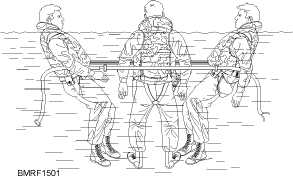especially true of persons whose stations are in the
lower part of the ship. However, a hit from a torpedo or
bomb or a collision with another ship may flood the
compartments normally used or knock out a ladder.
Often, some measure to control flooding taken by the
damage control party closes off the normal method of
travel.
The only answer to this situation is to know your
ship. Small ships don’t present much of a problem
because they have only a few routes you can follow.
However, large ships are another matter. Aboard an
aircraft carrier or cruiser, learning all the passageways,
doors, and ladders takes a long time. During leisure
time, learn escape routes from various below-deck
sections to the weather decks. Ask the individuals who
work in those sections the best way to get topside; then
follow that route. The time to experiment is before an
emergency occurs, not during one.
Going Over the Side
As in everything else, there is a right way and a
wrong way to abandon ship. Whenever possible, go
over the side fully clothed. Shoes and clothing may
hinder you while swimming; but in lifeboats, a covering
of any kind offers protection against the effects of sun
and salt water. In a cold climate, wear a watch cap to
keep your head warm. Take along a pair of gloves and
extra clothes if you can. Even in tropical waters you may
feel cool at night because you can do little to keep warm.
Normally, you should leave from whichever side of
the ship is lower in the water; but, if the propellers are
turning, leave from the bow. Leave by the windward
side whenever possible. Leaving from the lee side might
protect you from a stiff wind, but the same wind causes
the ship to drift down on you, often faster than you can
swim. Also, if oil is on the water, you can clear the slick
sooner by swimming into the wind.
Never dive, and do not jump unless you have to. Use
a ladder, cargo net, line, or fire hose. If you must jump,
do so feet first, legs together, and body erect. (First,
check the water so you will not land on debris or on
other personnel.) Except when jumping into flames, be
sure your life preserver is fastened securely, including
the leg straps. If you are wearing a vest-type preserver,
place one hand firmly on the opposite shoulder to keep
the preserver from riding up sharply when you hit the
water (in a long drop, the force of impact might hurt
your chin or neck). Hold your nose with your other
hand. If you are wearing an inflatable preserver, inflate
it after you have entered the water.
In the Water
Once you are in the water, your immediate concern
is to clear the ship as quickly as possible. Before you
rest, you should try to be 150 to 200 yards away from the
ship. When the ship goes down, it may create a strong
whirlpool effect, which might draw you down with the
ship if you are too close. Another advantage of distance
is that you will be safer if an explosion occurs.
After you are safely away from the ship, conserve
your energy. Don’t splash about or shout unnecessarily.
If any danger of underwater explosions exists, float or
swim on your back with your head and chest as far out of
the water as possible. Help your shipmates all you can,
and try to stay in groups (fig. 15-1). Get on a lifeboat, of
course, as soon as you can. In the meantime, grab
anything floatable that comes by, or just relax in the
water. Above all, remain calm!
SWIMMING AND FLOATING.—Check the
chart shown below. It tells you the requirements you
must meet to qualify as a third class, second class, and
first class swimmer.
Meeting the requirements for swimmer third class
won’t help you if you have to swim ½ mile to a lifeboat.
You can see that by qualifying for swimmer second
class, you’d have a better chance to survive. Better yet,
qualifying for swimmer first class gives you the best
chance for survival.
15-2
Student Notes:
Figure 15-1.—Joining life preservers.

